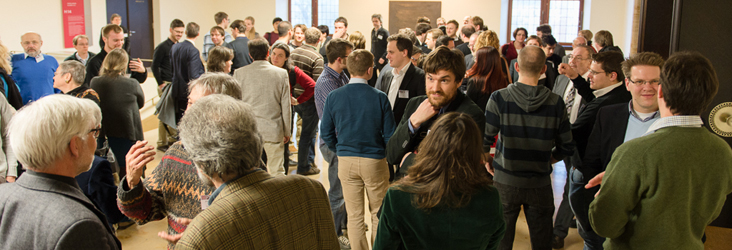
Events 2018
The Interdisciplinary Center for Scientific Computing (IWR) and its affiliated institutions organize a large number of workshops, conferences and other events for discussing latest scientific results as well as identifing upcoming challenges in the field of Scientific Computing. In addition the IWR regularly hosts events which emphasis on broadening and improving the interdisciplinary dialogue.
[January][February][March] [April] [May][June][July] [August] [September][October][November][December]
December
Talk
"Pioneering Structural Repair & Conservation in Angkor"
John Sanday OBE, FSA
December 18, 2018 • 16:00
John Sanday, Conservation Architect, who has spent the last 45 years working in Asia, worked for at least 20 of those years in Cambodia. Arriving for the first time in Siem Reap in 1989, he and his team pioneered the first project, the Preah Khan Conservation Training Project which was supported by the World Monuments Fund. The Khmer Rouge disturbances were still evident in Angkor as the fast-growing sub-tropical jungle, which engulfed the partially ruined monuments provided an ideal hiding place for the Khmer Rouge militia. John’s early memories were of the skirmishes still taking place on the outskirts of the historic city of Angkor and the sounds of explosions and gunfire – it was indeed a memorable start to several decades of working in one of the largest monumental cities of its time, which was later to be placed on the UNESCO World Heritage List.
John will briefly describe his early days of setting up the first major conservation training programme in the 12th Century Buddhist monastic complex. As many of you will be able to recall the time we have spent together in Angkor, I will take this opportunity to describe some of the problems we had to face and the techniques we developed in Preah Khan and three other sites in Angkor to conserve the structures with minimal intervention. There will be plenty of illustrations showing Angkor as John found it in the 1990’s and it will provide an excuse and set the background for him to side track to another Khmer style site in the far North of Cambodia.
Banteay Chhmar, one of the great Khmer sites, is closely linked to Angkor despite it being about 100km to its north. This 12th Century site, which is stylistically emulates the temples in Angkor of the Bayon period, is my link with IWR as it was the birth of an extraordinary project which Professor Georg Bock and had been fantasizing for many years trying to link heritage conservation with applied mathematics. We found a way of using ‘start of the art’ technology to digitally reconstruct a section of exquisite bas relief carvings on a stone enclosure wall which enclosed the temple complex known as Banteay Chhmar. This project need careful measurement and digital recreation of the fallen sections as the first step to their reconstruction following a highly sensitive conservation intervention to protect the decorative stone carvings. The Bas Relief Wall measures 1,400 metres in length of which 75% has collapsed.
Similarly, a free-standing sandstone tower supporting four carved images of, possibly the king or maybe the Buddha, measuring approximately 15 metres high, was threatening imminent collapse. These two different architectural elements were selected to test a system for digital re-assembly.
A section of the enclosure wall was selected. Each stone in was measured and referenced. Missing stones were located and the decorative stones were carefully dismantled and each stone was scanned. A process was also developed for the consolidation and cleaning of these masterpieces ready for reconstruction.
Drawings of the Tower were prepared referenced and carefully dismantled and each stone was scanned.
John will describe the system which IWR developed to solve “John’s Puzzle”, Khmer architect Dr. Peakdey Nguonphan and Dr. Ann from Germany headed up the team which developed the digital technology.
As a result of this multi-disciplinary research and along with support from many of the IWR teaching staff, the stones began to recognize their original positions in the structures and along with the knowledge and experience of the Khmer stone masons who had worked with us in Preah Khan, progress was made. I will explain the full process with illustrations.
Time will be allocated for questions ad discussions.
Location: Centre for Organismal Studies Heidelberg (COS) • Seminar Room 00.005 • INF 230 • 69120 Heidelberg
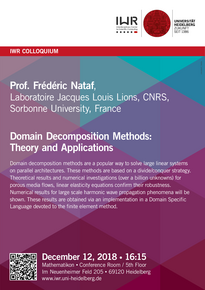
IWR Colloquium Winter Term 2018 / 2019
"Domain Decomposition Methods: Theory and Applications"
Prof. Frédéric Nataf • Laboratoire Jacques Louis Lions, CNRS, Sorbonne University, France
December 12, 2018 • 16:15
Domain decomposition methods are a popular way to solve large linear systems on parallel architectures. These methods are based on a divide/conquer strategy. Theoretical results and numerical investigations (over a billion unknowns) for porous media flows, linear elasticity equations confirm their robustness. Numerical results for large scale harmonic wave propagation phenomena will be shown. These results are obtained via an implementation in a Domain Specific Language devoted to the finite element method.
Location: Mathematikon • Conference Room / 5th Floor • Im Neuenheimer Feld 205 • 69120 Heidelberg
November

IWR Colloquium Wintersemester 2018 / 2019
14. November 2018 • 16:15 Uhr
Veranstaltung anlässlich des 60. Geburtstags von Prof. Dr. Eva Gutheil.
"Turbulente Brenngeschwindigkeit - Wie antworten Flammen auf ihre Strömungsumgebung"
Prof. Henning Bockhorn • KIT
"The Hot Drop Race: Multiphase Flow Control for Spray Processes in Enclosures"
Prof. Udo Fritsching • Universität Bremen
Die Teilnahme ist nach Anmeldung kostenfrei. Online-Registrierung
Veranstaltungsort: Mathematikon • Konferenzraum, 5. Stock, Raum 5/104 • Im Neuenheimer Feld 205 • 69120 Heidelberg

Veranstaltung
"Eröffnung des Scientific Computing Sustainable Software Collaboratory (SCSC)"
5. November 2018 • 15:00 Uhr
Mit der Verfügbarkeit leistungsfähiger Computer und Softwarewerkzeuge hat sich die mathematische Modellierung, Simulation und Optimierung (MSO), als zentrale Methodik des Wissenschaftlichen Rechnens, zu einer Schlüsseltechnologie entwickelt. Aktuelle Ergebnisse der MSO in der Hochschulforschung führen allerdings auf Grund befristeter Projekte oft nur zu prototypischer, nicht nachhaltiger Software. Dieses strukturelle Hindernis führt dazu, dass neue Verfahren ihr großes Potential zur Lösung der immer komplexeren Probleme in Wissenschaft, Industrie und Gesellschaft nur begrenzt entfalten. Mit der Einrichtung des durch die Carl-Zeiss-Stiftung geförderten SCSC sollen am IWR Strukturen geschaffen werden, die dieses Hindernis beseitigen und einen wirksamen Technologietransfer in inner- und außeruniversitäre Anwendungsbereiche ermöglichen.
Veranstaltungsort: Alte Aula der Universität • Grabengasse 1 • 69117 Heidelberg
October
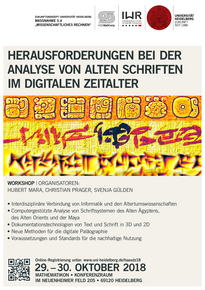
ZUK 5.4 Challenge Workshop
"Herausforderungen bei der Analyse von alten Schriften im digitalen Zeitalter" (HAASDZ18)
29. – 30. Oktober 2018 • Heidelberg
Der Challenge Workshop „Herausforderungen bei der Analyse von alten Schriften im digitalen Zeitalter", organisiert vom IWR in Zusammenarbeit mit den Akademievorhaben „Altägyptische Kursivschriften“ (Akademie der Wissenschaften und der Literatur, Mainz) und „Textdatenbank und Wörterbuch des Klassischen Maya“ (Nordrhein-Westfälische Akademie der Wissenschaften und der Künste) möchte Schnittmengen zwischen Informatik und Schrift- und Sprachforschern finden, um gemeinsam die Rätsel antiker Texte zu lüften.
- Kann Artificial Intelligence im digitalen Zeitalter das Rätsel alter Schriften und Sprachen knacken? Welche Computeranwendungen und Algorithmen helfen bei der Analyse antiker Schriften?
- Wie sehen die Dokumentationstechnologien von Text und Schrift in 3D und 2D aus?
- Welche neuen Methoden gibt es für die digitale Paläographie?
- Welche Voraussetzungen und Standards sind für die nachhaltige Nutzung notwendig?
- Diesen Fragen geht der interdisziplinäre Workshop mit zahlreichen Experten nach.
Der Workshop ermöglicht Vertretern verschiedener Disziplinen, die sich mit Computeranwendungen und quantitativen Methoden in der Schrift- und Sprachforschung beschäftigen, mehr über laufende Forschungsprojekte oder Abschlussarbeiten zu erfahren sowie über die Möglichkeiten und Grenzen verschiedener Methoden zu diskutieren. Im Mittelpunkt des Workshops steht die Zusammenarbeit zwischen Informatik und Altertumswissenschaften.
Neben Kollegen, Postdoktoranden und Doktoranden sind auch ausdrücklich Studierende, die ihre digitalen Kenntnisse erweitern, bzw. begonnene Arbeiten diskutieren möchten, herzlich willkommen.
! Anmeldung erfoderlich ! (Deadline: 15. Oktober 2018)
Veranstaltungsort: Mathematikon • Konferenzraum / 5. Stock • Im Neuenheimer Feld 205 · 69120 Heidelberg
Talk
"Fixed Point Theorems for Non-Continuous Mappings"
Prof. Hoang Xuan Phu • Institute of Mathematics, Vietnam Academy of Science and Technology
October 16, 2018 • 17:15
*Meet & Greet • 16:45 • Conference Room, 5th Floor*
There are various reasons for studying fixed-point property of non-continuous mappings, e.g., due to errors or perturbations, original mappings lose their contractivity or their continuity, and therefore, the existence of their fixed-points is no more warranted. To counteract this problem, we present some theorems on approximate fixed-points of roughly contractive mappings and roughly continuous mappings along with illustrating examples.
Location: Mathematikon, Conference Room, 5th Floor, Room 5/104, Im Neuenheimer Feld 205, 69120 Heidelberg
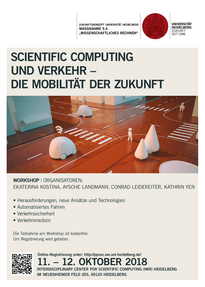
ZUK 5.4 Workshop
"Scientific Computing und Verkehr –
die Mobilität der Zukunft"
11. – 12. Oktober 2018 • Heidelberg
Die zunehmende Implementierung neuer Technologien im Straßenverkehr bedeutet nicht nur einen signifikanten Fortschritt in Bezug auf die Prävention von Unfällen und die Erhöhung der Verkehrssicherheit, sondern ermöglicht auch vollkommen neue wissenschaftliche Ansätze und Analysen.
Der interdisziplinäre Workshop „Scientific Computing und Verkehr – die Mobilität der Zukunft", organisiert vom IWR in Zusammenarbeit mit dem Institut für Rechtsmedizin und Verkehrsmedizin Heidelberg, richtet sich an Vertreter verschiedener Fachbereiche und Disziplinen und wird Themen aus den Bereichen „Automatisiertes Fahren“, „Verkehrssicherheit“ und „Verkehrsmedizin“ ansprechen. Hierbei sollen neueste Entwicklungen, laufende Projekte und innovative Forschungsideen vorgestellt werden.
- Automatisiertes Fahren: welche Daten können erhoben und genutzt werden, um den komplexen Strukturen des Verkehrs gerecht zu werden und diese zur Erhöhung der Verkehrssicherheit einzusetzen?
- Verkehrssicherheit: Durch Vernetzung welcher Technologien kann die Verkehrssicherheit erhöht werden? Wie muss die die Infrastruktur der Stadt der Zukunft aussehen und warum?
- Verkehrsmedizin: Wie können innovative computergesteuerte Systeme zur Analyse und Rekonstruktion der Verletzungsmechanik Verunfallter beitragen?
Die Teilnahme am Symposium ist kostenfrei. Da die Anzahl der Teilnehmer jedoch beschränkt sein wird, bitten wir um Registrierung bis spätestens 28.09.2018. Bitte beachten Sie, dass Sie sich für die Tage einzeln anmelden müssen!
Registrierung Tag 1 (11.10.2018) & Registrierung Tag 2 (12.10.2018)
Veranstaltungsort: Mathematikon • Seminarräume A & B • Im Neuenheimer Feld 205 · 69120 Heidelberg
IWR School
"Advances in Mathematical Optimization"
October 8-12, 2018 • Heidelberg, Germany
The IWR School 2018 focuses on important modern methods in the field of mathematical optimization. We target young researchers who want to deepen their knowledge of the methods that play a crucial role in solving demanding optimization problems in many application domains in science and engineering, economics, medicine, data analysis and increasingly in industrial and societal problems. The IWR School 2018 covers fundamental concepts, latest innovations and many practical applications of continuous, discrete and mixed-integer optimization as well as optimal control and game theory. The IWR School 2018 is taught in a series of courses by:
- Tobias Achterberg, Gurobi
- Hans Georg Bock, Heidelberg University
- Christian Kirches, Technical University of Braunschweig
- Ekaterina Kostina, Heidelberg University
- Martine Labbé, Université Libre de Bruxelles and INRIA
- Gerhard Reinelt, Heidelberg University
- Stephen J. Wright, University of Wisconsin‐Madison
! Registration required ! (Deadline: August 31, 2018)
Location: Mathematikon • Im Neuenheimer Feld 205 · 69120 Heidelberg
Symposium
"BIOMS Symposium 2018"
October 1-2, 2018 • Heidelberg, Germany
BIOMS (the Center for Modeling and Simulation in the Biosciences) in Heidelberg has been an initiative starting in 2004. The initiative aimed at establishing modeling approaches in the life sciences as a central discipline in Heidelberg. In the end of 2018 this initiative will finally come to an end. BIOMS especially financed junior groups and PostDocs over the years, many of which are now full professors at different institutions in Germany.
The symposium will address various aspects of modeling and simulation in the biosciences with a specific focus on biomechanics, multi-scale processes, information processing and method development.
There are still a number of possibilities for oral and poster contributions.
Abstract submission deadline: 15.06.2018
Notification of abstract acceptance: 30.06.2018
Registration deadline: 15.07.2018
Further information, a list of confirmed keynote speakers and a preliminary program can be found here.
Location: DKFZ Communication Center • Im Neuenheimer Feld 280 · 69120 Heidelberg
September
Talk
"Low-Rank Tensor Decompositions for High-Dimensional Uncertainty Quantification"
Dr. Sergey Dolgov • University of Bath, UK
September 20, 2018 • 17:00
Uncertainty quantification and inverse problems in many variables are pressingly needed tasks, yet high-dimensional functions are notoriously difficult to integrate in order to compute desired quantities of interest. Functional approximations, in particular the low-rank separation of variables into tensor product decompositions, have become popular for reducing the computational cost of high-dimensional integration down to linear scaling in the number of variables. However, tensor approximations may be inefficient for non-smooth functions. Sampling based Monte Carlo methods are more general, but they may exhibit a very slow convergence, overlooking a hidden structure of the function. In this talk we review tensor product approximations for the problem of uncertainty quantification and Bayesian inference. This allows efficient integration of smooth PDE solutions and quantities of interest. Moreover, we can use the low-rank approximation to construct efficient proposal density in the MCMC algorithm for inverse problems. This combined MCMC method is more accurate also if the quantity of interest is not smooth, such as the indicator function of an event.
Location: Mathematikon, Seminar Room A / Ground Floor, Im Neuenheimer Feld 205, 69120 Heidelberg
Talk
"Polynomial Acceleration of MCMC"
Prof. Colin Fox • University of Otago, NZ
September 20, 2018 • 16:15
Standard Markov chain Monte Carlo (MCMC) algorithms perform a stationary linear iteration on the space of probability distributions, and hence converge geometrically. Stationary linear solvers were state-of-the-art in the 1950’s, but are now considered very slow precisely because they are geometrically convergent. We show that the same polynomial acceleration methods that have been developed for linear iterative solvers may also be applied to accelerating MCMC, in certain settings.
Prof. Fox is the most recently appointed Romberg Visiting Scholar at the HGS MathComp.
Location: Mathematikon, Seminar Room A / Ground Floor, Im Neuenheimer Feld 205, 69120 Heidelberg
Talk
"New Energy Space Modeling and Implications on Complexity of Decision Making and Control in Electric Energy Systems"
Prof. Marija Ilic • Senior Research Scientist in LIDS, Massachusetts Institute of Technology (MIT), USA
September 5, 2018 • 16:15
In this talk we present a recently-introduced multi-layered modeling framework for posing the problem of safe, robust and efficient design and control for rapidly changing electric energy systems. The proposed framework establishes dynamic relations between physical concepts such as stored energy, useful work, and wasted energy, on one hand; and modeling, simulation, and control of interactive modular complex dynamical systems, on the other. In particular, our recently introduced energy state-space modeling approach for electric energy systems is further interpreted using fundamental laws of physics in multi-physical systems, which are modeled as dynamically interacting modules.
This approach is shown to be particularly well-suited for scalable optimization of large-scale complex systems. Instead of having to use simpler models, the proposed multi-layered modeling of system dynamics in energy space offers a promising basic method for modeling and controlling inter-dependencies across multi-physics subsystems for both ensuring feasible and near-optimal operation. It is illustrated how this approach can be used for understanding fundamental physical causes of inefficiencies created either at the component level or resulting from poor matching of their interactions.
This talk is based on the recent paper by M. D. Ilic and R. Jaddivada entitled "Multi-layered interactive energy space modeling for near-optimal electrification of terrestrial, shipboard and aircraft systems”, Annual Reviews in Control, available online May 2018. The paper provides theoretical foundations for Dynamic Monitoring and Decision Systems (DyMonDS) framework envisioned as the next-generation SCADA.
The control design based on joint work with Xia Miao and R. Jaddivada for microgrids and integration of renewable resources and demand response is used as an example to illustrate potential benefits of this approach.
Finally, many open modeling, estimation and optimization challenges/opportunities using this modeling approach are discussed.
*Get-Together at 15:30 Common Room (5th Floor)*
Location: Mathematikon • Conference Room / 5th Floor • Im Neuenheimer Feld 205 • 69120 Heidelberg
July
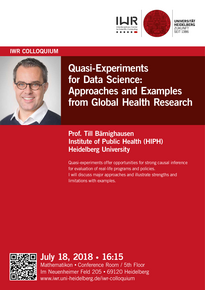
IWR Colloquium Summer Term 2018
"Quasi-Experiments for Data Science: Approaches and Examples from Global Health Research"
Prof. Till Bärnighausen • Heidelberg Institute of Public Health (HIPH)
July 18, 2018 • 16:15
Quasi-experiments offer opportunities for strong causal inference for evaluation of real-life programs and policies. I will discuss major approaches and illustrate strengths and limitations with examples.
Location: Mathematikon • Conference Room / 5th Floor • Im Neuenheimer Feld 205 • 69120 Heidelberg
Talk
"Spray Combustion: From a Flamelet Model to a Flamelet Theory"
Prof. Hernán Olguín • Universidad Técnica Federico Santa María, Valparaíso Chile
July 16, 2018 • 09:15
The task of formally extending the gas flamelet theory to spray flames has been only partially fulfilled and, whereas several spray flamelet models have been derived during the last decades, only few works regarding the spray flamelet equations (SFE) are available in the literature. Therefore, a degree of maturity similar to the one already achieved for gas flames has not yet been reached for spray flames. Among the remaining open issues is the closure of the SFE in mixture fraction space, which includes developing models for the Scalar Dissipation Rate (SDR) and for the different evaporation related sources appearing due to the consideration of a liquid phase.
In this presentation, recent advances in the closure of the SDR are described, which include a reformulation of the spray flamelet equations in terms of the gradient of mixture fraction instead of the SDR itself and the derivation of a transport equation for this new variable. The results are expected to help advancing towards the development of a self-contained spray flamelet theory.
Location: Mathematikon • Seminar Room 10 • Im Neuenheimer Feld 205 • 69120 Heidelberg

Public Lecture
"Geometry, Computers, and Art"
Richard Evan Schwartz • Chancellor’s Professor of Mathematics, Brown University, USA
July 12, 2018 • 17:00
Location: Mathematikon • Lecture Hall / Ground Floor • Im Neuenheimer Feld 205 • 69120 Heidelberg

15. Modellierungstag Rhein-Neckar
"Der Mensch im Modell"
5. Juli 2018 • 14:00 Uhr
Menschen machen Modelle interessant! Die immense Vielfalt von menschlichen Attributen, Verhaltensweisen oder Reaktionen sorgt aber auch dafür, dass die Modellbildung ungleich komplexer wird. Um beispielsweise einen Prozess im sozialen oder ökonomischen Leben realitätsnah abzubilden sollte ein möglichst exaktes Bild eines Menschen entworfen werden. Die Abwägung zwischen der Einfachheit eines Modells einerseits und seiner Aussagekraft andererseits stellt dabei eine der größten Herausforderungen dar. Wie gehen Modellierer sicher, dass die gewählten Ansätze nicht nur die jeweilige Forschungsfrage beantworten sondern auch allgemeine Gültigkeit besitzen?
Der Modellierungstag greift die spannende Frage nach der Bildung von „menschlichen Modellen“ auf und fördert den Austausch zwischen Forschern, Entwicklern und Anwendern. Beiträge aus unterschiedlichen Fachrichtungen liefern dazu Denkanstöße und Diskussionsgrundlagen.
Veranstaltungsort: Mathematikon • Konferenzraum / 5. Stock • Im Neuenheimer Feld 205 • 69120 Heidelberg
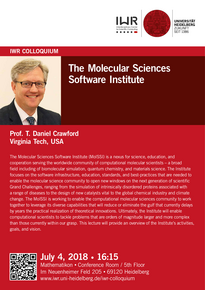
IWR Colloquium Summer Term 2018
"The Molecular Sciences Software Institute"
Prof. T. Daniel Crawford • Virginia Tech, USA
July 4, 2018 • 16:15
The Molecular Sciences Software Institute (MolSSI) is a nexus for science, education, and cooperation serving the worldwide community of computational molecular scientists - a broad field including of biomolecular simulation, quantum chemistry, and materials science. The Institute focuses on the software infrastructure, education, standards, and best-practices that are needed to enable the molecular science community to open new windows on the next generation of scientific Grand Challenges, ranging from the simulation of intrinsically disordered proteins associated with a range of diseases to the design of new catalysts vital to the global chemical industry and climate change. The MolSSI is working to enable the computational molecular sciences community to work together to leverage its diverse capabilities that will reduce or eliminate the gulf that currently delays by years the practical realization of theoretical innovations. Ultimately, the Institute will enable computational scientists to tackle problems that are orders of magnitude larger and more complex than those currently within our grasp. This lecture will provide an overview of the Institute’s activities, goals, and vision.
Location: Mathematikon • Conference Room / 5th Floor • Im Neuenheimer Feld 205 • 69120 Heidelberg
June
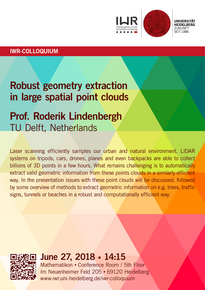
IWR Colloquium Summer Term 2018
"Robust geometry extraction in large spatial point clouds"
Prof. Roderik Lindenbergh • TU Delft, Netherlands
June 27, 2018 • 14:15
Laser scanning efficiently samples our urban and natural environment. LIDAR systems on tripods, cars, drones, planes and even backpacks are able to collect billions of 3D points in a few hours. What remains challenging is to automatically extract valid geometric information from these points clouds in a similarly efficient way. In the presentation issues with these point clouds will be discussed, followed by some overview of methods to extract geometric information on e.g. trees, traffic signs, tunnels or beaches in a robust and computationally efficient way.
Location: Mathematikon • Conference Room / 5th Floor • Im Neuenheimer Feld 205 • 69120 Heidelberg
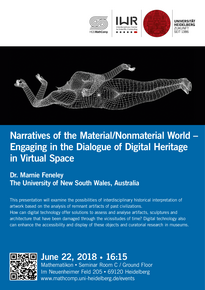
Talk
"Narratives of the material/nonmaterial world - engaging in the dialogue of digital heritage in virtual space"
Dr. Marnie Feneley • The University of New South Wales, Australia
June 22, 2018 • 16:15
This presentation will examine the possibilities of interdisciplinary historical interpretation of artwork based on the analysis of remnant artifacts of past civilizations. How can digital technology offer solutions to assess and analyse artifacts, sculptures and architecture that have been damaged through the vicissitudes of time? Digital technology also can enhance the accessibility and display of these objects and curatorial research in museums.
Dr. Marnie Feneley will present her research, past and present, which aims to reassess the out-dated Art Historical Analytical System. She will speak about new paradigms which seek to revise traditional methodologies of art historical analysis by using empirical methodology (for example, to analyse a large data set of Asian sculpture). In particular, the use of photogrammetric modeling and high-resolution immersive visualisation systems to address the traditional perceived (visual and verbal descriptive) analysis of art history along the Mercantile Maritime Route from India to China. The objective is to gain a deeper understanding of sculptural tradition, styles, religious affiliations and cultural transmissions in Asia from the 2nd - 14th century CE.
Dr. Marnie Feneley is a lecturer in Asian Studies at the University of NSW. As a post doctoral fellow, she has been researching the transmission of Buddhism from India to Southeast Asia for the "Atlas of Maritime Buddhism,” a world touring exhibition based on the compelling story of the spread of Buddhism through the seaports of Eurasia, supported by the latest archaeological evidence. Marnie has spent over a decade researching Southeast Asian sculpture and religion. Her doctoral thesis from the University of Sydney, “The West Mebon Viṣṇu: style, hydraulics and political power,” will be published later this year through National University of Singapore press. Her thesis examined the famous bronze sculpture of Viṣṇu found in a water shrine in the middle of the West Baray at Angkor in 1936. She has amalgamated archaeological and art historical research with digital technology by reconstructing this fractured sculpture and its temple in a digital reconstruction. She is considered a pioneer in the field digital archaeology and heritage. She regularly gives invited talks at national and international forums.
Location: Mathematikon • Seminar Room C / Ground Floor • Im Neuenheimer Feld 205 • 69120 Heidelberg
KoMSO Challenge Workshop
"Mathematical Modeling, Simulation and Optimization in the Pharmaceutical Industry"
June 14-15, 2018 • Heidelberg, Germany
As part of the BMBF’s “Mathematics for Innovations” programme the KoMSO Challenge Workshop entitled “Mathematical Modeling, Simulation, and Optimization in the Pharmaceutical Industry” will be held at the Interdisciplinary Center for Scientific Computing (IWR) on June 14 and 15, 2018.
The workshop aims at bringing together experts from pharmaceutical industry and academic research in order to determine which demand can be met by already existent mathematical methods, and to identify new challenges that require the development of new techniques for a sustainable progress in the pharmaceutical industry over the next ten to twenty years.
As in previous KoMSO Challenge Workshops, the results of this discussion will be documented in a position paper in order to promote the use of methods for mathematical modelling, simulation, and optimization in industrial practice also at the political level.
We kindly invite your contribution in oral presentations and in plenary discussions on this two-day workshop.
Confirmed speakers from industry and academia including (in alphabetical order):
- AbbVie Deutschland GmbH & Co. KG
- Bayer AG
- GoSilico GmbH
- Heidelberg Collaboratory for Industrial Optimization (HCO)
- Merck KGaA
- TU Berlin, Bioprocess Engineering
- Universität der Bundeswehr München
! Registration required ! (Deadline: June 12, 2018)
Location: Mathematikon • Conference Room / 5th Floor • Im Neuenheimer Feld 205 · 69120 Heidelberg

HGS MathComp Ladyzhenskaya Lecture
"Pore scale modeling of flows in weakly permeable porous media - a hybrid computational approach"
Dr. Anna Trykozko • University of Warsaw, Poland
June 13, 2018 • 16:15
Studying effective properties of porous media based on simulating flows at pore scale has become a widely applied procedure during last years. Realistic structures of pores are commonly obtained by X-ray computed micro-tomography (micro-CT). In this work we consider weakly permeable samples in which a significant fraction of porosity could not be detected at a micro-CT resolution. We therefore apply an approach in which parts of samples characterized as 'solids' during micro-CT imaging are treated as permeable porous media represented with an assumed (small) permeability. Reliable estimations of permeability of ‘solid’ parts were obtained by incorporating Scanning Electron Microscopy data. This way our computational hybrid approach combines two microimaging methods of different resolutions.
Location: Mathematikon • Conference Room / 5th Floor • Im Neuenheimer Feld 205 · 69120 Heidelberg
Conference
"16th European Finite Element Fair"
June 8-9, 2018 • Heidelberg, Germany
The European Finite Element Fair (EFEF) is an annual series of completely informal small workshops throughout Europe with equal initial conditions for each speaker. EFEF provides a platform for high-level discussions on current research on finite element approximation, in the broadest sense, of partial differential equations. Authors are encouraged to present one new idea rather than review a full research project. In this spirit, the communication of recent and new results, even not yet published, is very welcome. A few, but strict, rules apply to EFEF in order to distinguish it from existing workshops and minisymposia in the field.Format of the Meeting:
- Speakers at EFEF are volunteers from the audience. Provided that they are present throughout the meeting, all participants are invited to talk. Potential participants are strongly encouraged to attend at least one meeting before volunteering to speak.
- Based on the number of speakers the time available will be divided into slots for the talks. The order of the speakers will be determined through random choice, by drawing names out of a hat. Speakers cannot request a specific time to talk.
- The Presentations. Bring your presentation as a pdf-file on a USB-stick. That will make life/technical support much more relaxed and easier during the conference.
- Each speaker should introduce himself or herself, the title and topic, and is expected to leave sufficient time, within the allocated time-slot, for discussion. Speakers have to prepare a talk that can be trimmed to various lengths (from seconds to 20 minutes). For a smooth meeting, the time table will be strictly enforced.
- The Book. Since EFEF 2005, a book has been available (in the Oberwolfach tradition) to record new analytical and numerical results presented during EFEF. Results can be hand-written or typeset and glued into the book.
Location: Mathematikon • Conference Room / 5th Floor • Im Neuenheimer Feld 205 · 69120 Heidelberg
Talk
"Efficient stage-parallel time integration and tensor-product solvers for discontinuous Galerkin methods"
Will Pazner • Brown University, USA
June 7, 2018 • 16:15
Implicit time integration for discontinuous Galerkin (DG) discretizations is important in the context of boundary layer flows, anisotropic, unstructured meshes, and high degree polynomial approximations. Effective preconditioning strategies are essential to the efficient iterative solution of the resulting large, sparse linear systems. In this talk, I will discuss two topics: (1) fully implicit Runge-Kutta solvers, and (2) tensor-product preconditioners for very high polynomial degrees.
(1) There are several advantages to using fully-coupled implicit Runge-Kutta schemes compared with traditional DIRK or BDF methods. However, such methods couple all of the Runge-Kutta stages, resulting in a much larger system of equations. We transform the resulting system of equations to maximize sparsity, and then develop several ILU-based preconditioners with favorable performance properties. These solvers have the additional advantage that they allow for parallelism across the stages.
(2) Furthermore, the DG method allows for arbitrary order of accuracy, according to the degree of polynomial approximation used. High-degree polynomials result in extremely restrictive CFL conditions, motivating the use of implicit solvers. We develop efficient solvers and preconditioners that exploit the natural tensor-product structure of quadrilateral and hexahedral grids in order to obtain methods with optimal computational complexity.
Location: Mathematikon • Seminar Room A / Ground Floor • Im Neuenheimer Feld 205 • 69120 Heidelberg
Talk
"Mathematical Modeling and Simulations in Hemodynamics"
Prof. Adélia Sequeira • University of Lisbon, Portugal
June 6, 2018 • 11:15
Mathematical modeling and numerical simulations can provide an invaluable tool for the interpretation and analysis of the circulatory system functionality, in both pathological and healthy situations. However, although many substantial achievements have been made, most of the difficulties are still on the ground and represent major challenges for the coming years.
In this talk we introduce some mathematical models of the cardiovascular system and comment on their significance to yield realistic and accurate numerical results. They include fluid-structure interaction (FSI) models to account for blood flow in compliant vessels, analysis of absorbing boundary conditions to deal with the numerical spurious reflections due to the truncation of the computational domain and the geometrical multiscale approach to simulate the reciprocal interactions between local and systemic hemodynamics. Results on the simulation of some image-based patient-specific clinical applications will also be presented.
Location: Mathematikon • Conference Room / 5th Floor • Im Neuenheimer Feld 205 • 69120 Heidelberg
May
Vortrag
"On how to earn a living with optimization"
Prof. Frank Allgöwer • Vizepräsident der DFG, Universität Stuttgart
14. Mai 2018 • 15:00
Vortrag anlässlich des 70. Geburtstags von Prof. Dr. Dr. h.c. mult. Hans Georg Bock.
Veranstaltungsort: Alte Universität • Aula • Grabengasse 1 • 69117 Heidelberg
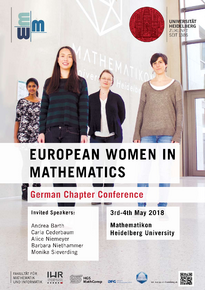
Conference
"European Women in Mathematics - German Chapter Conference 2018"
May 3-4, 2018
The 2018 German Chapter Conference of the European Women in Mathematics, organized by UPSTREAM - The Network for Women in Maths, Heidelberg, and the Konstanz Women in Mathematics: Paths in Studies and Career (KWIM), is a space supporting women in their careers and giving them prominence and visibility, the conference follows the EWM tradition since its foundation in 1986.
The aim of this conference is to promote communication and networking between mathematicians from all research areas, offering in particular a platform to female mathematicians at all academic stages for presenting their mathematical results, sharing their experiences and discussing the challenges related to the gender gap in this field.
The scientific programme will consists of one-hour talks by four keynote speakers, shorter contributed talks to be presented in parallel thematic sessions, and a poster session with one-minute presentations for each poster. The programme will include an invited talk on gender balance in academia encouraging active discussion among the participants about this issue for mathematicians in Germany.
Location: Mathematikon, Conference Room (5/104), 5th Floor, Im Neuenheimer Feld 205, 69120 Heidelberg
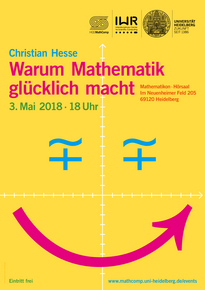
Öffentlicher Vortrag
"Warum Mathematik glücklich macht"
Prof. Christian Hesse • Universität Stuttgart
3. Mai 2018 • 18:00
Wie die Liebe und die Musik hat Mathematik die Gabe, Menschen glücklich zu machen. Angesichts ihrer oft kargen Darreichungsform eine kühne Behauptung? Dafür, dass sie dennoch stimmt, soll in diesem Vortrag der Beweis angetreten werden. Mit grandiosen Schönheiten des Denkens, amüsanten Geschichten und fantastischen Anwendungen der Mathematik.
Der Eintritt ist frei.
Veranstaltungsort: Mathematikon • Hörsaal / EG • Im Neuenheimer Feld 205 • 69120 Heidelberg
March
Conference
"7th International Conference On High Performance Scientific Computing"
March 19-23, 2018 • Hanoi, Vietnam
Topics: Modeling, Simulation and Optimization of Complex Processes
Detailed information can be found at the conference websites
http://www.math.ac.vn/HPSCHanoi2018/
http://hpsc.iwr.uni-heidelberg.de/HPSCHanoi2018/
The conference is jointly organized by the IWR and the Institute of Mathematics, Vietnam Academy of Science and Technology.
February
Workshop
"DUNE/PDELab Course"
Prof. Peter Bastian • IWR
February 26 - March 2, 2018
The Distributed and Unified Numerics Environment (DUNE) is a software framework for the numerical solution of partial differential equations with grid-based methods. Using generic programming techniques it strives for both: high flexibility (efficiency of the programmer) and high performance (efficiency of the program). DUNE provides, among other things, a large variety of local mesh refinement techniques, a scalable parallel programming model, an ample collection of finite element methods and efficient linear solvers.
DUNE-PDELab is a powerful tool for implementing discretisations of partial-differential equations. It helps to substantially reduce the time to implement discretizations and solvers for (systems of) PDEs based on DUNE. It is not only suitable for rapid prototyping but also for building highly performant simulation software and is used by a variety of projects already.
This one week course will provide an introduction to the most important DUNE modules and especially to DUNE-PDELab. At the end the attendees will have a solid knowledge of the simulation workflow from mesh generation and implementation of finite element and finite volume methods to visualization of the results. Topics covered are the solution of stationary and time-dependent problems, as well as local adaptivity, the use of parallel computers and the solution of non-linear PDE’s and systems of PDE’s.
Location: Mathematikon • Conference Room / 5th Floor • Im Neuenheimer Feld 205 • 69120 Heidelberg
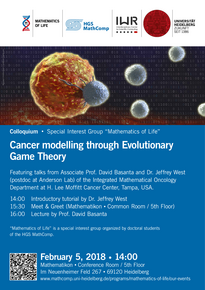
"Mathematics of Life" Special Interest Group - Colloquium
"Cancer Modelling Through Evolutionary Game Theory"
Prof. David Basanta & Dr. Jeffrey West • H. Lee Moffitt Cancer Center, USA
February 5, 2018 • 14:00
Evolutionary game theory (EGT) has recently become a popular modelling framework for understanding, modeling, and treating cancer. EGT is a quantitative framework for modeling evolution and natural selection. The purpose of this event is to introduce the attendees to the topic, the limitations of EGT and the research questions that are being tackled in the field. The event features an introductory talk to this research area by Dr. Jeffrey West and a scientific lecture from Prof. David Basanta. Both speakers are researchers from the Integrated Mathematical Oncology Department at H. Lee Moffitt Cancer Center, Tampa, USA.
Dr. Jeffrey West - "Modeling the evolution of cancer from a game theoretic perspective"
Tumor development is an evolutionary and ecological process in which a heterogeneous population of cells with different growth capabilities compete for space and resources. In this Darwinian competition, systemic therapy strongly selects for resistant phenotypes, leading to eventual unconstrained proliferation of resistant populations even when no drug is present—an evolutionary phenomenon called “competitive release.” Often, the evolution of resistance comes at a cost, as it requires diversion of cellular resources from proliferation and invasion to the resistance mechanism.
What are the minimal ingredients needed to recreate some of the emergent features of such an evolving complex ecosystem? The first section of this talk will provide an overview of important game theoretic modeling frameworks historically used in modeling cancer progression and therapeutics: deterministic replicator dynamics, stochastic Moran process models, and spatial cellular automata games. The complex interactions within the tumor ecosystem can often be recast in the form of a game payoff table, to which the analytical tools of evolutionary game theory can be applied. In the second half, we highlight the utility, clarity, and power that such models provide, despite (and because of) their simplicity and built-in assumptions.
Prof. David Basanta - "Evolutionary Game Theory to define cancer ecology and evolution"
The importance of evolutionary dynamics in cancer cannot be understated, making mathematical tools like Evolutionary Game Theory (EGT) well suited to investigate the emergence and fixation of phenotypes typically characterized by the hallmarks of cancer. Importantly, and even if not part of the strictest definition of EGT, the storm can be made part of the game and its role studied in connection to the progression of the tumor and its response to treatment. In this talk I will review some of my work in these topics and debate the merits of abstract versus experimentally-driven approaches in mathematical oncology.
14:00 Introductory tutorial by Dr. Jeffrey West
15:30 Meet & Greet (Mathematikon • Common Room / 5th Floor)
16:00 Lecture by Prof. David Basanta
Location: Mathematikon • Conference Room / 5th Floor • Im Neuenheimer Feld 205 • 69120 Heidelberg

14. Modellierungstag Rhein-Neckar
"Geobasierte Modelle"
1. Februar 2018 • 14:00
Mathematische Modelle kommen in unserem Alltag in vielfältigen Varianten vor. Dabei spielt die Lokalisierung eine besonders wichtige Rolle: Ein abstraktes Modell wird konkretisiert, indem es mit lokalen Daten angereichert und so präzise für einen Kunden angepasst wird.
Die geografische Komponente ist vor allem in der modellgestützten Optimierung eine entscheidende Größe. Ein Beispiel mag dies verdeutlichen: Während die Fahrroutenoptimierung in nicht-geobasierten Modellen auf abstrakte Grundgrößen wie durchschnittliche Fahrtzeit von Ort zu Ort zurückgreifen muss, können in Modellen mit detaillierten geografischen Daten exakte Vorhersagen für die Fahrtdauer beim Einsatz unterschiedlicher Fahrzeuge der zur Verfügung stehenden Flotte errechnet und in die Planoptimierung eingespeist werden. Die Kopplung mit aktuellen Verkehrsdaten erlaubt sogar eine tagesabhängige Nachoptimierung und so eine noch bessere Anpassung der Fahrpläne an die realen Gegebenheiten.
Diese Verbesserungen können auch in vielen anderen Bereichen erreicht werden:
- Modellierung der Ausbreitung von Infektionserkrankungen in Abhängigkeit von regionalem Klima und Wetter
- Hochwasservorhersage auf Basis detaillierter Geländekarten
- Planung von Funknetzwerken unter Berücksichtigung von Bebauungsplänen
Der Zusammenhang zu geografischen Daten ist so offensichtlich, dass die Anbindung geografischer Informationssysteme oft selbstverständlich erscheint. Auf dem Modellierungstag wollen wir uns mit dieser Facette der Modellbildung beschäftigen und auf Schwierigkeiten bei der Modellerstellung, Risiken in der Datengenerierung und Chancen im wirtschaftlichen Einsatz eingehen. Experten aus Wissenschaft, Forschung und Praxis geben dazu Einblicke in aktuelle Projekte und neue Entwicklungen.
Der Modellierungstag Rhein-Neckar eröffnet Praktikern und Wissenschaftlern die Gelegenheit, Innovationen zur Diskussion zu stellen, Gemeinsamkeiten und Unterschiede der verwendeten Modellierungsansätze herauszuarbeiten und den gegenseitigen Erfahrungsaustausch zu pflegen.
Veranstaltungsort: Mathematikon • Konferenzraum / 5. Stock • Im Neuenheimer Feld 205 • 69120 Heidelberg
January
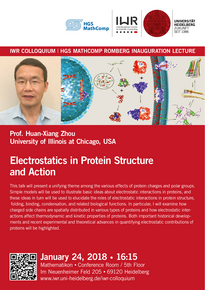
IWR Colloquium Winter Term 2017 / 2018
"Electrostatics in Protein Structure and Action"
Prof. Huan-Xiang Zhou • University of Illinois at Chicago, USA
January 24, 2018 • 16:15
Proteins are made up of 20 types of amino acids with varying physical properties. Amino acids with ionizable and polar groups, through forming ion pairs, hydrogen bonds, and other less specific electrostatic interactions, impart important properties to proteins. Modulation of the charges on these amino acids, e.g., by pH and by phosphorylation and dephosphorylation, have profound effects such as protein denaturation and switch-like response of signal transduction networks. This talk will present a unifying theme among the various effects of protein charges and polar groups. Simple models will be used to illustrate basic ideas about electrostatic interactions in proteins, and these ideas in turn will be used to elucidate the roles of electrostatic interactions in protein structure, folding, binding, condensation, and related biological functions. In particular, I will examine how charged side chains are spatially distributed in various types of proteins and how electrostatic interactions affect thermodynamic and kinetic properties of proteins. Both important historical developments and recent experimental and theoretical advances in quantifying electrostatic contributions of proteins will be highlighted.
Prof. Zhou is the most recently appointed Romberg Guest Professor at the HGS MathComp. The program invites distinguished researchers to stay at the graduate school for an extended period. Over the course of three years, the Romberg professors are visiting the graduate school several times, developing new ideas in close collaboration with doctoral students and fellow researchers.
Location: Mathematikon • Conference Room / 5th Floor • Im Neuenheimer Feld 205 • 69120 Heidelberg
Talk
"Difference Operators in Sobolev Spaces and Applications"
Prof. Alexander L. Skubachevskii • RUDN University, Russia
January 24, 2018 • 10:15
The theory of elliptic differential-difference equations has many interest-ing applications e.g. to
- the theory of sandwich shells and plates,
- the Kato problem concerning the analyticity of the square root of an analytic function of dissipative operators,
- nonlocal boundary value problems arising in plasma theory,
- the theory of multidimensional diffusion processes,
- nonlinear optics, …
This theory is based on the properties of difference operators acting in Sobolev spaces. Most important property of a regular difference operator:
It maps the Sobolev space of the first order with the homogeneous Dirichlet boundary condition onto the subspace of the Sobolev space of the first order with nonlocal boundary conditions continuously and bijectively. This result allows to reduce boundary value problems for strongly elliptic differential-difference equations to elliptic equations with nonlocal boundary conditions. Conversely, in some cases nonlocal elliptic boundary value problems can be reduced to elliptic differential-difference equations.
Location: Mathematikon • Seminar Room 12 / 5th Floor • Im Neuenheimer Feld 205 • 69120 Heidelberg
67. Bildverarbeitungsforum
"10 Jahre Heidelberg Collaboratory for Image Processing (HCI)"
12. Januar 2018 • 13:00 - 20:00 Uhr
Die Bildverarbeitung am Interdisziplinären Zentrum für Wissenschaftliches Rechnen (IWR) hat sich über die Jahrzehnte aus kleinen Anfängen kontinuierlich und organisch weiterentwickelt. Von Anfang an war die Grundlagenforschung eng mit Applikationen aus den Umwelt- und Lebenswissenschaften und der Industrie verknüpft. Zehn Jahre erfolgreiche Zusammenarbeit zwischen Forschung und Industrie im HCI sind einen Rückblick auf das Konzept, die wichtigsten Forschungsergebnisse und einen Ausblick auf die Zukunft wert, in einer Sonderveranstaltung des Heidelberger Bildverarbeitungsforums und eines gemeinsamen Festkolloquiums der Fakultät für Physik und Astronomie und des IWR.
> Die Teilnahme ist kostenfrei - Anmeldung erforderlich <
Veranstaltungsort: Hörsaalgebäude Physik • Hörsaal 1 • Im Neuenheimer Feld 308 • 69120 Heidelberg
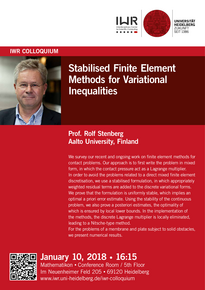
IWR Colloquium Winter Term 2017 / 2018
"Stabilised Finite Element Methods for Variational Inequalities"
Rolf Stenberg • Aalto University, Finland
January 10, 2018 • 16:15
We survey our recent and ongoing work [1,2] on finite element methods for contact problems. Our approach is to first write the problem in mixed form, in which the contact pressure act as a Lagrange multiplier. In order to avoid the problems related to a direct mixed finite element discretisation, we use a stabilised formulation, in which appropriately weighted residual terms are added to the discrete variational forms. We prove that the formulation is uniformly stable, which implies an optimal a priori error estimate. Using the stability of the continuous problem, we also prove a posteriori estimates, the optimality of which is ensured by local lower bounds. In the implementation of the methods, the discrete Lagrange multiplier is locally eliminated, leading to a Nitsche-type method [3].
For the problems of a membrane and plate subject to solid obstacles, we present numerical results.
Joint work with Tom Gustafsson (Aalto) and Juha Videman (Lisbon).
References:
[1] T. Gustafsson, R. Stenberg, J. Videman. Mixed and stabilized finite element methods for the obstacle problem. SIAM Journal of Numerical Analysis 55 (2017) 2718–2744
[2] T. Gustafsson, R. Stenberg, J. Videman. Stabilized methods for the plate obstacle problem. arxiv.org/abs/1707.08396
[3] E. Burman, P. Hansbo, M.G. Larson, R. Stenberg. Galerkin least squares finite element method for the obstacle problem. Computer Methods in Applied Mechanics and Engineering 313 (2017) 362–374
Location: Mathematikon • Conference Room / 5th Floor • Im Neuenheimer Feld 205 • 69120 Heidelberg
Talk
"Processes in Branching Networks - Modelling Structures in Plant Physiology and Blood Vessels in the Human Heart"
Dr. Somporn Chuai-Aree • Prince of Songkla University, Thailand
January 10, 2018 • 14:15
Mathematical modelling and simulation of physiological processes in organs and organisms are confronted with the challenge that the processes take place in complex structures, often on branching networks. In this lecture we consider networks arising in plants (“trees”, root-systems, vessel systems in leaves) and in vascular systems - in particular in cardio vascular systems. We are going to focus on the following topics:
- characterization of the arising complex networks and construction of a coding system, including the essential information required in real applications;
- requirements for the data, methods for data collection and processing;
- algorithms to solve the geometric inverse problem to determine from CT-data the geometry and the developed code of the underlying network;
- presentation and discussion of results obtained in recent research at IWR for the blood vessel system for the human heart, based on real CT-data;
- open problems, requirements from the applications.
Location: Mathematikon • Seminar Room 12 / 5th Floor • Im Neuenheimer Feld 205 • 69120 Heidelberg